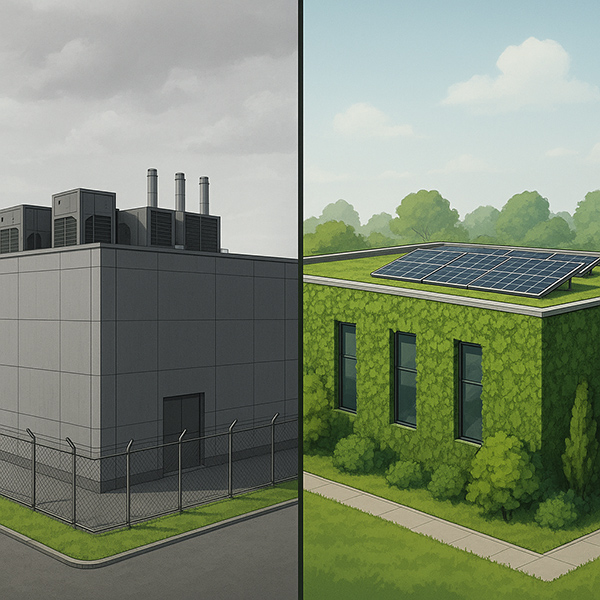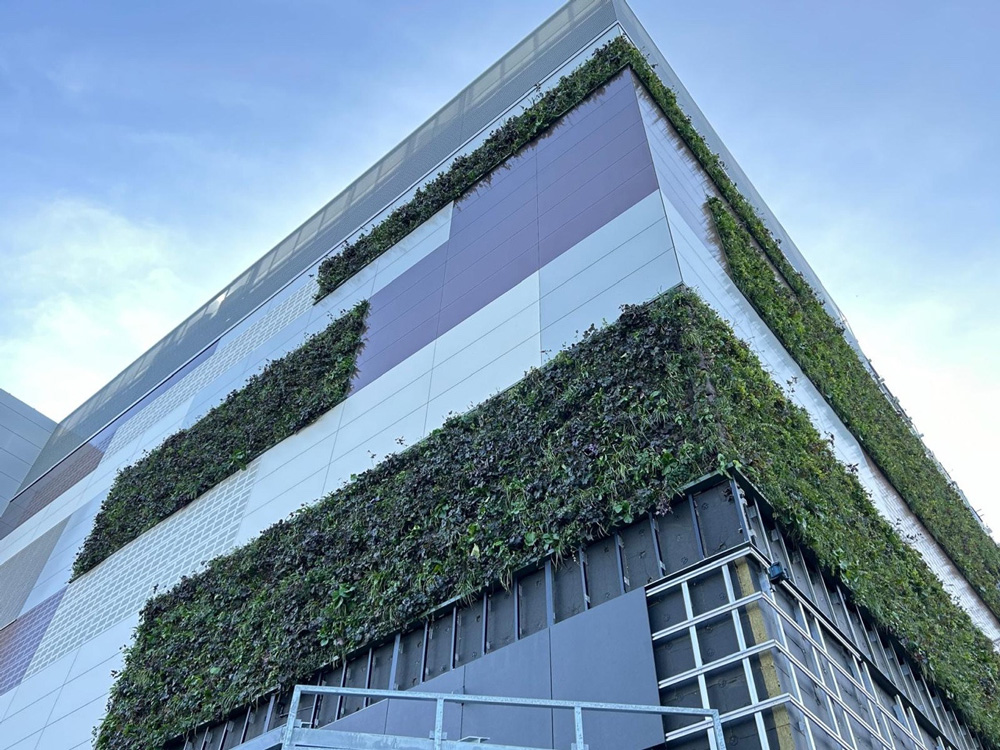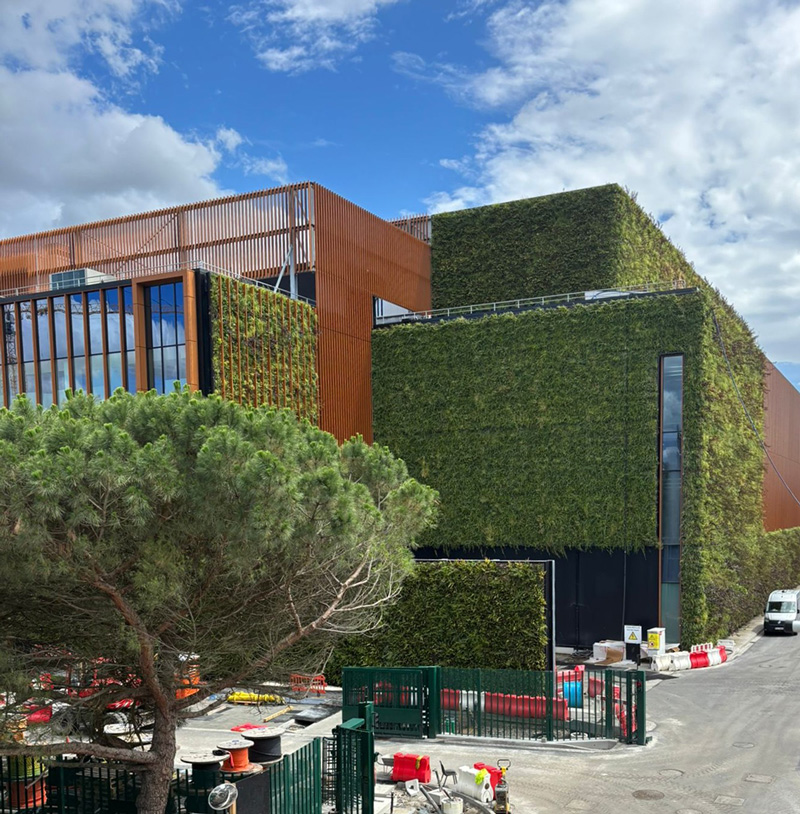Green data centres: The future of sustainable technology
Posted on Tuesday 12 August, 2025The demand for data centres continues to grow exponentially. The world is rapidly becoming digitalised, and the rise of AI requires even greater data exchange—further driving this demand. Cities like London, Frankfurt, Paris, Dublin, and Amsterdam play a crucial role in the internet’s infrastructure. These cities serve as true internet hubs and are home to the most important data centre locations in Europe. However, there is a downside to all these data centres. Their growth places a significant burden on the environment. From high energy consumption to the vast areas these facilities occupy, data centres leave a substantial environmental footprint. They also cause noise pollution due to the constant operation of cooling systems and servers. In addition, they contribute to rising ambient temperatures, which can impact the local climate and reduce quality of life in surrounding areas. Fortunately, there’s good news too! New data centre developments are emerging that take environmental and climate concerns seriously. How does this work? In this blog, we take a closer look at the world of these massive digital strongholds.
The green data centre – what is it?

What sets a green data centre apart from traditional ones? A green data centre distinguishes itself through its focus on sustainability and energy efficiency. Unlike conventional data centres, which often rely on fossil fuels and pay little attention to their environmental impact, a green data centre uses innovative technologies and design principles to minimise its ecological footprint.
This includes the use of renewable energy sources such as solar and wind power, as well as heat recovery systems that reuse residual heat. A green data centre also integrates water-saving cooling systems and strives for maximum energy efficiency—beneficial not only for the environment but also for reducing long-term operational costs.
Additionally, green roofs and living walls are used to help cool the building and increase the efficiency of solar panels. The greenery also contributes to greater biodiversity. Moreover, green façades and rooftops help reduce noise pollution and lower ambient temperatures. And perhaps most striking—although intentionally subtle—green façades and roofs reduce visual impact on the landscape. Thanks to their integration with nature, green data centres blend seamlessly into their surroundings.
Green roofs and living walls on data centres
A green data centre goes beyond energy efficiency. It involves the integration of environmentally friendly technologies such as green roofs, solar panels, and green façades. This approach not only reduces environmental impact but can also lower costs and extend the lifespan of equipment through improved temperature regulation.
- Green roofs: A green roof covered with Sedum plants helps regulate temperature and mitigates the urban heat island effect. This can also reduce the cooling costs of the data centre. In addition, green roofs enhance biodiversity and provide rainwater retention, which is especially beneficial in densely built urban areas.
- Solar panels: By equipping a data centre roof with solar panels, a large portion of the required energy can be generated locally and sustainably. This not only reduces reliance on fossil fuels but also acts as a buffer against rising energy costs.
- Living walls: Vegetation along the building’s façades can support urban integration and has a positive effect on air quality, air temperature, and noise levels. Green façades can also serve as an aesthetic solution to make large, often anonymous buildings more visually appealing to the surrounding area.

Curious about the best solution for combining a green roof with solar panels? Read more here.
Does the energy-neutral data centre exist?
Yes! What was once merely an ambitious dream has now become a reality. A great example is the Dublin Edge project in Ireland. This data centre runs entirely on renewable energy and also uses heat recovery technology. Projects like this prove that an energy-neutral data centre is not only achievable but can also serve as a model for future developments in the sector.
Europe is also stepping up in promoting sustainability

In 2023, the EU introduced new reporting requirements for data centres. These rules require companies to be transparent about their energy consumption and sustainability efforts. Such regulations put pressure on businesses to adopt energy-efficient and sustainable technologies—crucial, because without regulation, the transition to sustainability would likely take much longer. You can read more about this in this article.
In addition to these regulations, there is also a broader movement in which governments offer subsidies and tax incentives to companies that invest in green technologies. These incentives make it more attractive for data centres to commit to sustainable practices.
Urban integration of data centres
As the number of data centres continues to grow, so does the pressure on urban areas. Many data centres are built in prominent locations due to their need for high-speed network connectivity. As a result, they often face strict building regulations and urban planning constraints.
Green roofs and green facades can help integrate data centres more harmoniously into the urban environment. Additionally, waste heat from data centres can be reused to heat surrounding buildings—saving energy and improving local acceptance of these facilities within communities.
The future is energy-neutral – and data centres play a key role

Green data centres offer an opportunity to combine cutting-edge technology with sustainability. By integrating green roofs, solar panels, and green facades, data centres can not only reduce their ecological footprint but also contribute to a healthier urban environment. Moreover, innovations such as advanced cooling systems, AI-driven energy optimisation, and waste heat reuse play a crucial role in achieving energy neutrality.
The shift toward a green approach is no longer optional—it’s a necessity. With increasing regulation, urban pressure, and rapid technological advancement, we have the opportunity to transform this critical infrastructure into a sustainable pillar of the future. By investing in green solutions today, data centres can not only meet current sustainability standards but also be well-prepared for the challenges of tomorrow.
Would you like to learn more and explore how to make your project greener?
Schedule your appointment here – we’d be happy to think along with you.
